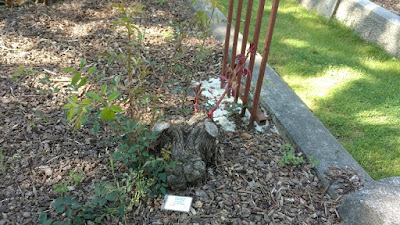
|
|
Plenty of bushes, although smaller than in past springs, are in bloom in the City Cemetery rose garden. (Photos: Debbie Arrington)
|
With climbers cut down, arches soon will be gone in Sacramento's Historic City Cemetery
At the height of a pandemic, I went looking in Sacramento’s Historic City Cemetery for solace. Amid the sunshine and flowers, I found some comfort, beauty and peace.
But I also saw something missing.
This weekend would have been the cemetery’s annual Open Gardens celebration, attracting hundreds of visitors from throughout Northern California to see its world-famous Heritage Rose Garden and other collections. Of course in light of coronavirus, that event has been indefinitely postponed. Organizers hope to reschedule it this fall.

|
|
A large Mons. Tillier tea rose, introduced in 1891, graces a grave.
|
But as a city park, the cemetery remains open and free to visitors daily. The cemetery’s hundreds of rare roses don’t know their garden party was canceled. They bloomed anyway.
At least most of the bushes bloomed. Missing this spring are the climbing roses that graced dozens of metal arches. Each April, they gave the cemetery rose garden a distinctly romantic look and heavenly scent.
Sometime in February, all the climbers were chopped down. Several other big bushes were severely whacked, too.

|
This arbor is usually covered with blooming roses in spring. On either side,
the vigorous climbers sprout new growth. The City plans to dismantle
the arbor soon.
|
This was way beyond winter pruning, which was done by the rose garden’s volunteers in December and January. The arbor display destruction was heart-breaking for the volunteers who had been tending those plants for years.
“Nearly all of the roses next to the arbors were cut severely back, in two cases to the ground,” said Anita Clevenger, the Heritage Rose Garden’s former curator.
The arbors were at the crux of a long-running dispute between city officials and rose lovers. Arches between plots were deemed “not historically accurate and would be removed,” according to the technical advisory committee formed to create guidelines for the cemetery’s gardens.
Rose garden volunteers were told they could keep trellises inside plots to help train the bushes. But those trellises disappeared, too.
“The city removed every piece of rebar and the metals frames that we used to support the roses without any discussion with or explanation to the nonprofit group under which the rose garden operates (the Old City Cemetery Committee) or to any of the volunteers,” Clevenger said.

|
|
The stump of what was once a gigantic climber --
Souvenir de Mme. Leonie
Viennot -- sprouts new canes.
|
“We had worked for years to find ways to train and support the roses to their best display, and keep the roses out of the paths and from touching the monuments. Nobody is asking any of the rose people anything or telling them anything.”
The bush reduction – or rejuvenation, depending on viewpoint – was supervised by Tom Liggett, a rose expert from San Jose. He was instrumental in the creation of that city’s historic rose garden. Liggett, who wrote a book on rose pruning, believes extremely hard pruning can force an old rose bush to push out strong new canes.
“Some of Tom’s pruning worked very well and the roses have responded with bloom, although on smaller plants,” Clevenger observed. “The climbing and many of the species and other once-bloomers (roses that bloom only once a year) are producing much less bloom on plants that are a shadow of their former magnificence.”
The arches apparently will soon be history, or at least in their former configuration.
When asked for comment, the City of Sacramento issued this statement Thursday:
“The City continues to prioritize preservation of the historic cemetery. The roses in the cemetery were recently pruned to preserve the rose plants’ longevity and health under the expertise of volunteer Tom Liggett.
“The roses will not be allowed to grow back over the remaining arches because the arches were determined to be unsafe and do not align with the City’s historic preservation guidelines.
“The arches will be removed to preserve the historic nature of the cemetery. The City is open to working with cemetery volunteers to find appropriate places to have arches in the cemetery, for example along the perimeter.”
The good news: There are still plenty of roses to see. And many of the severely pruned roses do seem to be recovering, although it will be several springs before they reach their previous size – if ever.
But roses are resilient – just like our city. I saw many reminders of that, too, during my visit.
Pandemics are not new to Sacramento. The 1850 cholera epidemic put more than 600 early residents into the City Cemetery, which opened the year before at the height of the Gold Rush.
Flu pandemics in the late 1800s and early 1900s killed thousands more Sacramentans. Families often lost multiple children; their gravestones reflect those waves of death.
Surrounding those markers is so much life – not just the roses, but thousands of other flowers. The cemetery’s perennial and California native gardens are also in full bloom.
In the absence of foot traffic, wildlife is on full display, too. Birds, bees and butterflies enjoy the warm spring weather and abundant blooms.
Although the roses may not be as spectacular as in past springs, they’re still there for the most part. Even bushes that were chopped way down seem to be attempting a comeback.
That gave me hope, too.




